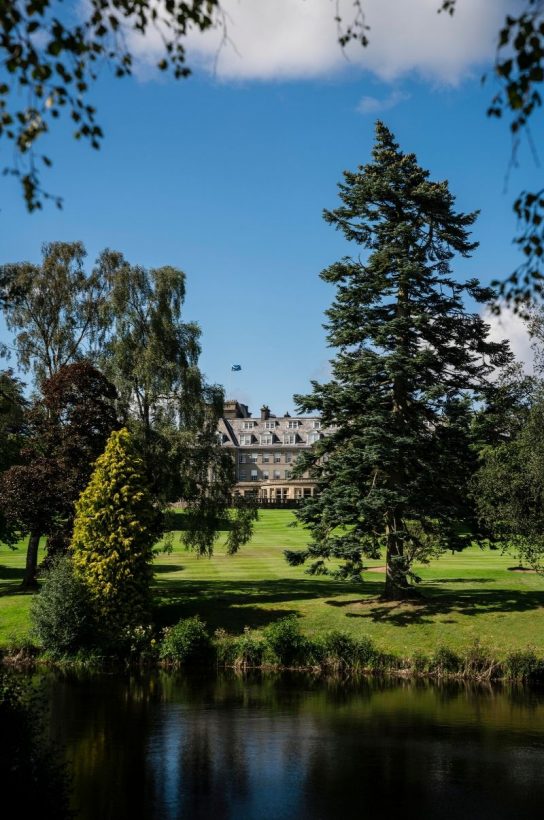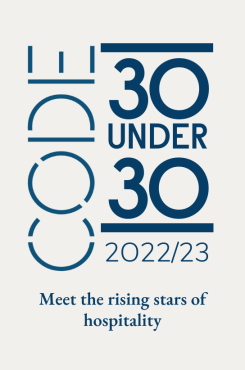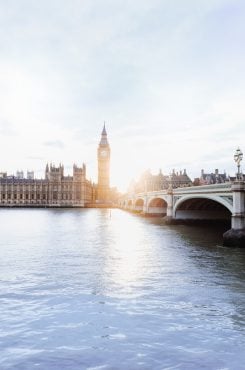


Almost one hundred years old, the Gleneagles hotel has a winning combination of rich Scottish heritage and modern, dynamic management. Adam Hyman explores an estate where the hospitality is as dazzling and wide-ranging as the views
There’s something about the light in Scotland. Even when it’s raining, there’s a light that seems as though your eyes have just been Windowlened. It’s like you’ve been walking around with smudged vision for ages or that moment when you clean your eyewear and suddenly realise what clean lenses are like. Apparently it’s to do with the lack of pollution in the atmosphere.
I noticed this as we made our way from Edinburgh Waverley train station to Gleneagles. After a couple of text messages to let us know the exit to take and where he would be waiting, our chauffeur Calum picked us up in a Gleneagles branded Mercedes V-Class to drive us the hour-or-so journey to the 5-star hotel. The next two days were to explore the famous Scottish hotel that was originally built by the Caledonian Railway Company and opened in 1924.
Dubbed ‘a Riveria in the Highlands’ and a ‘Palace in the Glen’, the venue soon established itself as one of the greatest leisure destinations in the world. Fast forward to 2015, and Ennismore – the young, dynamic brand behind the Hoxton hotels – bought the estate from the FTSE 100 drinks behemoth Diageo.

On the very pleasant four-hour train journey from London to the Scottish capital, I had a clear perception of what Gleneagles would be. What I experienced over the 48 hours I spent there was very different. I was expecting a compact venue, the twoMichelin-starred Restaurant Andrew Fairlie and a golf course. I envisaged wealthy guests decamping from their stressful offices for a few days in the Scottish countryside. A little like the Roy family from HBO’s Succession – who in fact filmed an episode for the second season at Gleneagles.
In reality, the sporting estate couldn’t be more different from what I imagined. There are elements of architecture that give a nod to the railway company that built it; this becomes even clearer when you step into the dimly lit lobby, which was redesigned by David Collins Studio after Ennismore purchased the estate. As you walk towards reception, off to the right of the lobby sits the Century Bar, which was also relaunched and refurbished by the aforementioned London-based designer, in collaboration with local Scottish artisans. The large space is constantly kept occupied by hotel guests, visitors and golfers either looking for a midmorning coffee, post-round cold beer or to sample one of Scotland’s finest collection of old and rare whiskies.
The sprawling hotel sits on 850 acres and has more than 230 bedrooms with views across the estate. Guests at the hotel range from golfers, those wanting to take part and try their hand at some country pursuits (we dabbled in some clay pigeon shooting and a walk down to the Loch), as well as couples or families looking to escape to the country for some downtime. Yet for me, it was the food and drink offering that I was most interested in for this visit, especially upon discovering that they have nine outlets in the hotel.

Since Ennismore has run the estate, it’s worked at shrugging off that perception that Glenealges is purely for golfers – and they’ve put a renewed focus on their restaurants. Executive chef Simon Attridge oversees all of the food offerings at Gleneagles, which ranges from the afternoon tea at The Glendevon (the room that most famously held the G8 summit of world leaders in 2005) to their fine dining restaurant, The Strathearn (the Andrew Fairlie restaurant is run independently of the hotel).
While talking to Attridge in the kitchen of The Strathearn, it’s clear the day job keeps him busy. The chef, who previously worked at the Shangri-La in the Shard, told me, “we can have up to 1,000 staff working across the restaurants during the summer months when the hotel is at full capacity and we are also hosting weddings and events.” Not only is that a feat for any hotel, but what I immediately thought of most when Attridge made that comment was where they find all those staff from?
However, it’s clear that Gleneagles has a special draw for hospitality professionals. Throughout my stay I noticed familiar faces from dining rooms and bars back in London – this must help when it comes to recruitment, which is such a challenge across the industry at the moment.

You could spend a few days at Gleneagles and not have to eat in the same restaurant twice, apart from breakfast at the Strathearn, although I can’t see why anyone would complain about this – it’s one of the finest breakfast buffets I’ve had in a while. Even if, like us, you dined at Restaurant Andrew Fairlie the night before, you manage to find space for a full Scottish, with haggis, black pudding and the obligatory tatty scones.
The orangery at the rear of the restaurant makes for a relaxing setting to enjoy the papers and a breakfast before a day of outdoor pursuits in the Highlands. Dinner at the Strathearn is a similarly extravagant affair with the dimly lit restaurant and the plump cushioned banquets reminiscent of a bygone era – transforming you to simpler times perhaps. Tableside service is a big part of dinner and is something we should see more of in restaurants – let’s embrace the steak Diane.
The beauty of Gleaneagles is that it ticks all the boxes. Whether you want a more casual bite to eat in the Birnham, a room service of pizza fresh from the Dormy’s pizza oven, or a pre-dinner martini in the glamorous surrounds of the American Bar, before dinner at Restaurant Andrew Fairlie or The Strathearn, it’s all possible. And they’ve resisted the ultimate cliché at Gleneagles – there isn’t a bit of tweed in sight.
CODE was a guest of Gleneagles. To visit their website, click here
This article was first published in the 2019 winter edition of the CODE Quarterly. To subscribe, click here



